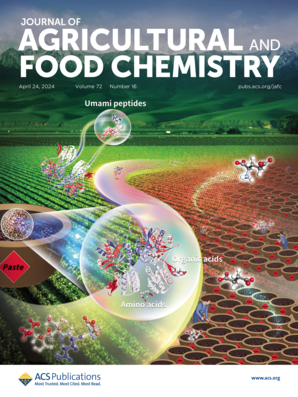N6-Methyladenosine Modification Regulates Prunus Necrotic Ringspot Virus Infection in Cucumis sativus
IF 5.7
1区 农林科学
Q1 AGRICULTURE, MULTIDISCIPLINARY
引用次数: 0
Abstract
N6-methyladenosine (m6A) is a common epigenetic modification found in eukaryotic RNA. Recent studies have increasingly highlighted the importance of m6A modification in plant defense against viruses. In this investigation, we found that prunus necrotic ringspot virus (PNRSV) infection affected the m6A modification process. Plant transcriptomes and epitranscriptomes were sequenced to coanalyze the dynamic changes of m6A modifications after PNRSV infection. Further studies revealed that the silencing of evolutionarily conserved C-terminal region (ECTs), encoding m6A readers, led to increased PNRSV accumulation, indicating that ECTs confer resistance to PNRSV. Additionally, we demonstrated that UPF3 and SMG7, which are involved in non-sense-mediated mRNA decay pathways, as well as phenylalanine ammonia-lyase (PAL), a well-known key enzyme in plant defense and an identified m6A-modified gene following PNRSV infection, play crucial roles in regulating PNRSV infection. These findings provide new insights into understanding PNRSV infection and further elucidate the role of m6A in modulating viral infection in plants.

n6 -甲基腺苷修饰调控黄瓜李坏死环斑病毒侵染
n6 -甲基腺苷(m6A)是真核生物RNA中常见的表观遗传修饰。近年来的研究越来越强调m6A修饰在植物抗病毒中的重要性。本研究发现,桃李坏死环斑病毒(PNRSV)感染影响了m6A的修饰过程。对植物转录组和表转录组进行测序,共同分析PNRSV感染后m6A修饰的动态变化。进一步的研究表明,编码m6A读取器的进化保守的c端区(C-terminal region, ECTs)的沉默导致PNRSV积累增加,表明ECTs赋予了对PNRSV的抗性。此外,我们还证实了UPF3和SMG7参与非意义介导的mRNA衰变途径,以及苯丙氨酸解氨酶(PAL),一种众所周知的植物防御关键酶和PNRSV感染后鉴定的m6a修饰基因,在PNRSV感染调控中发挥重要作用。这些发现为了解PNRSV感染提供了新的见解,并进一步阐明了m6A在调节植物病毒感染中的作用。
本文章由计算机程序翻译,如有差异,请以英文原文为准。
求助全文
约1分钟内获得全文
求助全文
来源期刊
CiteScore
9.90
自引率
8.20%
发文量
1375
审稿时长
2.3 months
期刊介绍:
The Journal of Agricultural and Food Chemistry publishes high-quality, cutting edge original research representing complete studies and research advances dealing with the chemistry and biochemistry of agriculture and food. The Journal also encourages papers with chemistry and/or biochemistry as a major component combined with biological/sensory/nutritional/toxicological evaluation related to agriculture and/or food.

 求助内容:
求助内容: 应助结果提醒方式:
应助结果提醒方式:


